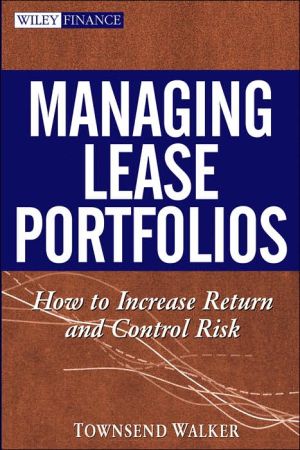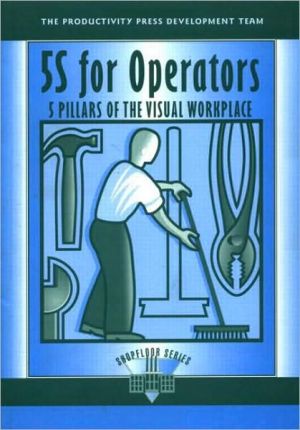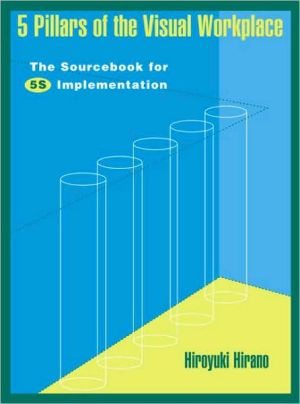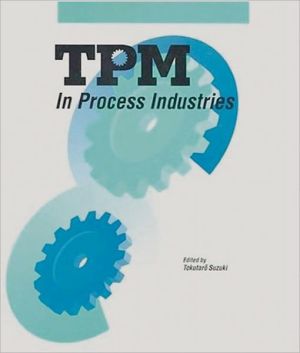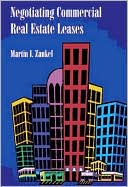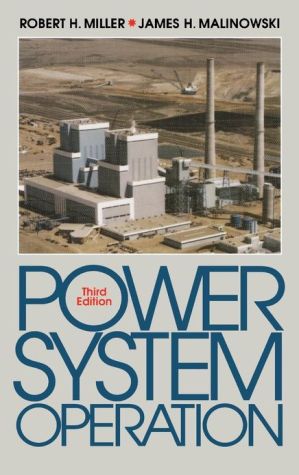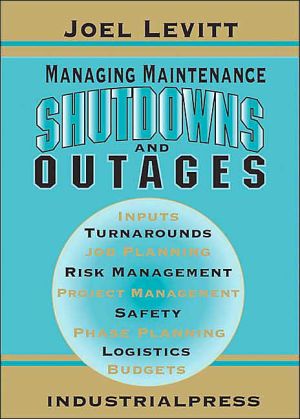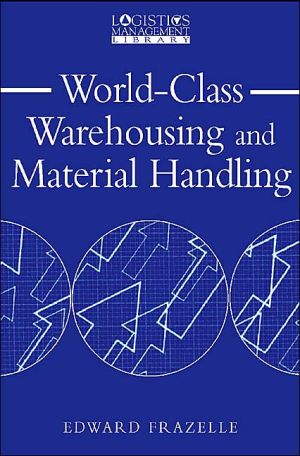Managing Lease Portfolios: How to Increase Return and Control Risk
Praise for Managing Lease Portfolios\ "This is a tour de force of modern financial theory applied to the lease product. Logical and well written, it is a perfect blend of theory and application. The comprehensive examples, charts, equations, and references add tremendous insight into the unique issues associated with leasing. I know of no other text that integrates these concepts so successfully."\ —James J. Jordan, CFA, SVP-Investments, Verizon Capital Corporation.\ "Townsend Walker is...
Search in google:
Leasing is one of today's more complex forms of financing, and, unless you have extensive experience in this arena, making informed decisions can be difficult. Over the life of a lease, its risks and returns change, and the factors that affect the risks and returns also change. In Managing Lease Portfolios, Townsend Walker, an expert in this field, explains how to evaluate the risk of lease portfolios as well as hedge their long-term, non-traded risks. Here, you'll learn how to apply various financial tools to your portfolio of leases and discover the work that goes into each step—such as measuring the risks of a lease, calculating the returns, and estimating the effects of diversification. Many of the ideas and concepts found within this comprehensive resource have existed for a number of years in the fields of foreign exchange, interest rate and credit derivatives, and the bond and stock markets. This book adapts and applies these concepts to managing leases. Then it illustrates how you can implement these new concepts through concrete models that have been proven to work in the real world.The book covers other topics that will allow you to become proficient in a portfolio approach to leasing. They include:The options embedded in a lease, how to calculate their value, and how much you should be charging lessees for the optionsHow the use of economic factors underlying lessee credit and equipment can be tracked to prices and become early warning indicators of troubleCommonly implemented strategies for risk reduction in the marketsThe portfolio management function in a leasing company—putting the tools into an organizational contextFilled with in-depth insight, easy-to-understand models, and practical advice, Managing Lease Portfolios gives leasing professionals a set of tools that will enable them to manage their businesses with a more comfortable and confident hand.
Managing Lease Portfolios\ \ By Townsend Walker \ John Wiley & Sons\ ISBN: 0-471-70630-2 \ \ \ Chapter One\ What a Lease Looks Like \ This chapter is an introduction to leases. One aim is to provide sufficient information about leases for those unfamiliar with them, but more importantly, the purpose is to orient you to a particular way of looking at a lease-as a bundle of cash flows that provides a return to the leasing company, with each cash flow changing in importance over time, and each cash flow being subject to certain risks.\ REASONS TO LEASE RATHER THAN BUY\ According to a recent survey three of the main reasons a company leases equipment rather than buying it are:\ 1. Leasing equipment protects companies against owning equipment that may become technologically obsolete-that risk is shifted to the lessor.\ 2. Often the company does not have to show the equipment and the debt financing it on its balance sheet. On their face, the financials of the company leasing the equipment look better than they otherwise would.\ 3. The company leasing the equipment cannot make use of the depreciation benefits.\ CHARACTERISTICS OF A LEASE\ A lease is a contract that lets a company (lessee) rent equipment for a specified period of time. The rent is paid periodically throughout the term of the lease-every month, or every 3, 6, or 12 months. The leasing company (lessor) owns the equipment.\ Lessors deduct the depreciation charges for the equipment from their income before calculating their taxes. Lessees receive part of the tax benefit of depreciation in the form of lower rent.\ How a Lease Works\ The way a lease works can be described in five steps:\ 1. A company needs new equipment. It specifies the make, model, and features, and negotiates the price with the manufacturer.\ 2. The company then negotiates an agreement with a lessor-how much rent, for how long, and what the equipment will be worth at the end of the lease.\ 3. The equipment is delivered. The company and the lessor make sure it is what was ordered. The lessor pays for it.\ 4. Rent payments are made by the company, now a lessee, to the lessor.\ 5. At the end of the lease the lessee may have an option to renew the lease or to buy the equipment.\ WHY LEASING IS DIFFERENT\ Leasing is unique in three fundamental ways:\ 1. The lessor owns the equipment and is not simply financing it. In most cases, a lessor buys a piece of equipment only when it has a customer who wants to use it. In the case of airplanes and rail cars, however, there are leasing companies that order planes and rail cars without specific customer orders in the hope they will be able to lease the equipment when it is delivered.\ 2. Leases are long. Though a computer lease probably lasts no more than three years, the lease on a rail car may last up to 25 years, and the lease on a power plant for 30 years. This means that at the start of the lease it is not easy to take into account everything that can happen to the equipment or to the lessee for the next 3 to 30 years.\ 3. There is no organized market for buying and selling leases. Leases are not traded like bonds or stocks because there are not enough common characteristics among them. Lease prices do not show up on Bloomberg or Reuters. There is a reasonably active private market for syndicating leases when they are originated. Sales of seasoned leases (2 to 10 years old), however, are not common, so if a lessor is unhappy with the risk or return on a lease it has in portfolio, it may take a while to fix the problem. This lack of a ready market means that the lessor must be careful when deciding what leases it wants in portfolio and have the tools for tracking what is happening with the lessee, the equipment, and tax rates and regulations.\ ATTRACTIONS OF A LEASE TO A LESSOR\ Four distinct advantages make a lease attractive to a lessor:\ 1. Regular cash flow from the rent payments.\ 2. The prospect of making a profit on selling the equipment when the lease is over.\ 3. Tax benefits of depreciation on the equipment.\ 4. Ability to further enhance the value of a lease with a creative financial structuring.\ However, that which is valued is always at risk against a change in the value. The sources of value to the lessor are sources of risk-the lessee can stop paying rent, the equipment may not be worth very much at the end of the lease, the depreciation may not be as valuable as was calculated at the start of the lease, or the structure turns out to be overly aggressive when viewed later by tax and accounting auditors.\ SETTING THE RENT ON A LEASE\ Five things are taken into consideration when determining the amount of rent:\ 1. The value of the equipment today and what it will be worth at the end of the lease.\ 2. The likelihood the lessee may stop paying the rent.\ 3. The value of being able to take depreciation on the equipment.\ 4. The cost to the lessor of borrowing the money to buy the equipment.\ 5. The amount the lessor needs to charge, and keep in reserve, to cover the risk of getting the preceding four estimates wrong.\ DIFFERENT KINDS OF LEASES\ There are four basic kinds of leases:\ 1. Single investor leases. This is the most common type of lease. The lessor supplies all of the money to buy the equipment. The length of the lease cannot be more than 80 percent of the useful life of the equipment to be eligible for tax treatment. The rent paid by the lessee is set by taking into account rental payments, depreciation, and the value of the equipment at the end of the original lease term. Because of the value of the depreciation tax benefits and the lease end value of the equipment, the rental payments are generally lower than interest and principal payments on a similar loan. The lessor monitors the ability of the lessee to pay rent and is concerned about the value of the equipment at lease end, as well as the value of the tax benefits.\ 2. Leveraged leases. The principal difference from a single investor lease is that the lessor supplies less than the entire cost of the equipment, an equity portion of somewhere between 20 percent and 40 percent. Lenders (commercial banks and insurance companies) provide the rest as debt. The lessor receives the tax benefits and resale rights from owning the equipment, but is not responsible to the lenders for paying off the debt in the event the lessee stops paying rent. On the other hand, the lessor is second in the pecking order in the event the lessee goes bankrupt. The lenders have first rights to the proceeds from selling the equipment plus additional proceeds from the lessee's estate. Leveraged leases are generally used for longer-lived and larger types of equipment. The benefits of this structure are greater and they cost more to put together.\ 3. Operating leases. The principal difference between an operating lease and the others is that its length is substantially shorter than the useful life of the equipment. Equipment like airplanes and rail cars can have 25- to 30-year lives. A lessor buys them and rents them out five to seven years at a time. The lessor usually supplies all the money to buy the equipment. Though the lessor monitors the ability of the lessee to make rent payments, the lessor is less concerned, relative to other leases, because it owns equipment that is a commodity and it can easily be leased to someone else. The principal problems operating lessors face are industry downturns, not individual lessee difficulties.\ 4. TRAC leases. TRAC stands for "terminal rental adjustment clause." These leases are limited by law to over-the-road vehicles-tractors, trucks, buses, and auto fleets. The principal difference with this type of lease is that the lessor bears no risk on the equipment at the end of the lease. A terminal value is agreed to at the beginning of the lease. If the vehicle sells for more than that value, the lessee gets a rebate on its rent; if it sells for less, the lessee pays the lessor the difference.\ Table 1.1, on page 6, summarizes the principal distinctions among leases. The last column in the chart is about risk. In this book, risk means uncertainty. When looking at the future we generally have some idea about the way things (prices, values) will end up-on average. Measures of risk tell us about the range and clustering of future prices around the average. Is there a small chance of a large positive result, or a large chance of a large negative outcome? Chapter 2 defines risk in more specific statistical terms.\ LEASES AS A SET OF CASH FLOWS\ The last column of Table 1.1 is the focus of this book-how to get a better handle on measuring the risks of a lease and the return you are getting for taking those risks. One of the first steps in that process is to break a lease into cash flow streams that are generated by the different elements in a lease. Understanding them and their interaction will enable you to manage them better.\ Table 1.2 shows the principal cash flows of a single investor lease from the point of view of the lessor.2 The equipment cost $1,000,000 and is bought on January 1, 2005. It is depreciated over five years. Only federal taxes of 35 percent are calculated. You do not need to look at the details of the calculations, only notice certain characteristics of the cash flows.\ * In the "Taxable Income" column, the lessor's taxable income is negative in the first three years of the lease because depreciation is greater than rent in these years. The lessor or its parent company is able to deduct this amount from other income before calculating income taxes.\ * In the "Taxes" column the effect of the depreciation is evident-the lessor saves $75,000 in taxes in the first three years, and it's not until year six of the lease that it pays any taxes on a net basis.\ * If you look at the total of "Pre-Tax Cash Flow" (unaffected by depreciation) and the total of "Taxes," you'll see that the lessor pays a 35 percent tax rate. Depreciation doesn't eliminate the tax bill, it pushes it off into the future. And that is valuable.\ * Note the difference between the "After-Tax Cash Flow" series and the "Accounting Income" series. They total to the same number but are very different in timing. This is due to the accounting conventions governing leases. Income for accounting purposes is computed by calculating the amount the lessor has invested in the lease in any year, and multiplying that amount by the rate on the transaction. This is, as is evident, very different than the pattern of the way cash is received by the lessor. In this book we'll focus primarily on the economic risks of the transactions.\ * The "Termination Value" column shows what the lessor has at risk any year during the lease. It includes the rents to be paid, equipment value, and the value of taxes that have been deferred. In a single investor lease the termination value decreases as time goes on.\ CONTRIBUTIONS OF RENT, EQUIPMENT, AND TAXES\ One way of looking at the changing contributions over time is to calculate the present value of the remaining cash flows each year. This number will give you a picture of what is important today and the change in importance over time. It's as if you were walking along in time and were able to take a look at what you cared about most each year. Figure 1.1 shows the changes in rent, equipment, and tax contributions.\ * As time goes on, the contribution of equipment increases because the day the equipment is coming back to the lessor becomes closer.\ * The cash received by the lessor (rent) is the most important consideration in the lease up until the last couple of years, though it declines as the rent payments are made.\ * Taxes that had been deferred are paid toward the end of the lease.\ The composition of risks that affect the lessor's return is shifting as the importance of the value streams shifts. This is one of the dynamics of the lease. The other dynamic is that the nature of the risks themselves shifts as time goes on.\ DIFFERENCES BETWEEN A LEVERAGED LEASE AND A SINGLE INVESTOR LEASE\ The introduction of a lender into the lease structure changes the dynamics and interactions of the cash flows from the perspective of the lessor. The changes are most easily tracked by looking at the cash flows of a leveraged lease. Table 1.3 illustrates a 20-year leveraged lease. The assumptions are that the equipment costs $1 million today and it will be worth $200,000 at the end of 20 years. The lease starts on January 1, 2005. The equipment is depreciated over seven years. The lessor puts in $225,314 in equity; the remainder is borrowed from a bank. As in the previous example, you do not need to look at the details of the calculations, only notice certain characteristics of the cash flows.\ * In the "Taxable Income" column, the lessor's taxable income is negative in the first eight years of the lease. (It was three years for the single investor lease.) This is because depreciation and interest are greater than rent in these years. The lessor or its parent can deduct this amount from other income before calculating income taxes.\ * In the "Taxes" column the effect of the depreciation is evident-the lessor saves $286,000 in taxes in the first eight years, and it's not until the last year of the lease that it pays any taxes on a net basis.\ * If you look at the total of "Pre-Tax Cash Flow" (unaffected by depreciation) and the total of "Taxes," you'll see that the lessor pays a 35 percent tax rate. Again, depreciation doesn't eliminate the tax bill, it pushes it off into the future. With a leveraged lease the delay is even more dramatic than with a single investor lease, even adjusting for the difference in tenors of the examples. * Looking at "After-Tax Cash Flow" and "Accounting Income" you can see, as with the single investor lease, a significant difference between economics and accounting due to the accounting convention for leases, though the difference is not as great as with the single investor lease. Focusing on the accounting results often distorts the view of what the underlying economics are, sometimes hiding the economics from view, which in turn prompts people to take actions to improve accounting results, but not for risk or economics. Figure 1.2 compares the cash flow and accounting results.\ * The significant difference between leveraged leases and single investor leases is in the lessor's exposure to risk, and its ability to do something about it. Note in the "Termination Value" column that the amount at risk increases for eight years before starting to decline. And because of the contractual arrangements with the lessee and lender, the lessor is last in line in the event the lessee cannot pay.\ FACTORS THAT CONTRIBUTE TO LEASE VALUE\ A couple of calculations will make it easier to see what is happening to the values of rent, equipment, and taxes from the start throughout the lease. Figure 1.3 shows the present value of the cash flow streams as a percent of total cash flows over time for each year of the lease. As in the single investor example, you are walking through time to see what the values look like every year.\ * As time goes on the contribution of Equipment increases, as the day the equipment comes back to the leasing company draws nearer.\ * The lessor does not receive any cash until the eighth year of the lease and then some at the end. This is reflected in the chart. The importance of the cash (rent less debt service) increases up to the time it comes in, falls off, and then increases slightly. Compared to Figure 1.1, the single investor lease, cash is much less important.\ * Tax benefits are the driver for a leveraged lease. Compare Figure 1.3 to Figure 1.1. The reason for the dominance of the tax flow is that even though the lessor puts up only 25 percent of the money to buy the equipment, it takes 100 percent of the equipment depreciation and deducts the interest on the debt. As with the single investor lease, the composition of risks that affect the lessor's return is shifting as the importance of the value streams is shifting.\ (Continues...)\ \ \ \ \ Excerpted from Managing Lease Portfolios by Townsend Walker Excerpted by permission.\ All rights reserved. No part of this excerpt may be reproduced or reprinted without permission in writing from the publisher.\ Excerpts are provided by Dial-A-Book Inc. solely for the personal use of visitors to this web site. \ \
Ch. 1What a lease looks like1Ch. 2Equipment risk17Ch. 3Credit risk47Ch. 4A tool for risk pricing leases73Ch. 5Tax risk91Ch. 6Options in a lease99Ch. 7Lease returns107Ch. 8Diversification121Ch. 9Factor analysis139Ch. 10Portfolio risk and return149Ch. 11Hedging a leasing portfolio165Ch. 12Portfolio management in a leasing company175
